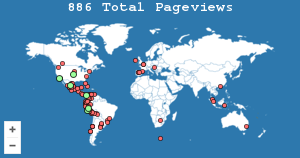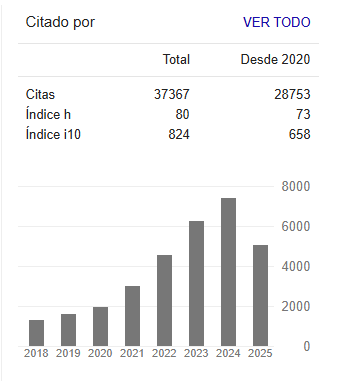Capacitación de personal: Gestión de atención en Call Center de EsSalud
Abstract
La investigación buscó demostrar la incidencia del nivel de los cursos de capacitación en las trabajadoras del Call Center de EsSalud en la efectividad del otorgamiento de citas en línea en el departamento de Huancavelica en el Perú; investigación orientada en el paradigma positivista de enfoque cuantitativo y de diseño correlacional causal, técnica de regresión ordinal. Los resultados indican que los cursos de capacitación en las trabajadoras del Call Center de EsSalud inciden significativamente en la efectividad del otorgamiento de citas en línea en el departamento de Huancavelica en el Perú, por lo que se concluye que los cursos de capacitación de las trabajadoras del Call Center de EsSalud son esenciales para incrementar la eficiencia y productividad en el trabajo desarrollado.References
Aktaş, Esra., Çiçek, Işık & Kıyak, Mithat (2011), The effect of organizational culture on organizational efficiency: The moderating role of organizational environment and CEO values. Procedia - Social and Behavioral Sciences, 24, Turquia, 1560–1573. http://doi.org/10.1016/j.sbspro.2011.09.092
Albayrak, Gulcag & Albayrak, Ugur (2014), Organizational Culture Approach and Effects on Turkish Construction Sector. APCBEE Procedia, 9, Turquia, 252–257. http://doi.org/10.1016/j.apcbee.2014.01.045
Aldhuwaihi, Abdullah., Shee, Himanshu K. & Stanton, Pauline (2012), Organisational Culture and the Job Satisfaction-Turnover Intention Link : A Case Study of the Saudi Arabian Banking Sector, 2(3), Australia, 127–141.
Ali, Qamar, & Rehman, Manqoosh ur (2011), Cultural Diagnosis: An Empirical Investigation of Cellular Industry of Pakistan, Asian Journal of Business Management, 3(4), Pakistan, 278–286.
Al-Khalifa, Khalifa N., & Aspinwall, Elaine M. (2001), Using the competing values framework to investigate the culture of Qatar industries. Total Quality Management, 12(4), Qatar, 417–428.
Appelbaum, Steven H., Audet, Lynda & Miller, Joanne C. (2003), Gender and leadership? Leadership and gender? A journey through the landscape of theories. Leadership & Organization Development Journal, 24(1), Canada, 43–51. http://doi.org/10.1108/01437730310457320
Bajdo, Linda M. & Dickson, Marcus W. (2001), Perceptions of Organizational Culture and Women’s Advancement in Organizations : A Cross-Cultural Examination. Sex Roles, 45(5/6), Estados Unidos, 399–414.
Balogh, Agnes., Gaál, Zoltán.& Szabó, Lajos (2011), Relationship between organizational culture and culture intelligence. Management & Marketing, 6(1), 95–110. http://doi.org/10.1097/JAC.0b013e3181ff6ef2
Belias, Dimitrios., Koustelios, Athanasios., Vairaktarakis, George & Sdrolias, Labros (2015), Organizational Culture and Job Satisfaction of Greek Banking Institutions. Procedia - Social and Behavioral Sciences, 175, Grecia, 314–323. http://doi.org/10.1016/j.sbspro.2015.01.1206
Belias, Dimitrios & Koustelios, Athanasios (2013), The influence of gender and educational background of Greek bankn employees on their perceptions of organizational culture. International Journal of Human Resource Management and Research (IJHRMR), 3(5), Grecia, 1–10.
Bellou, Victoria (2010), Organizational culture as a predictor of job satisfaction: the role of gender and age. Career Development International, 15(1), Grecia, 4–19. http://doi.org/10.1108/13620431011020862
Borna, Shaheen & White, Gwendolen (2003), “Sex” and “Gender”: Two Confused and Confusing Concepts in the “Women in Corporate Management” Literature. Journal of Business Ethics, 47(2), Holanda, 89–99. http://doi.org/10.1023/A:1026082400801
Brady, David., Isaacs, Katelin., Reeves, Martha., Burroway, Rebekah & Reynolds, Megan (2011), Sector, size, stability, and scandal: Explaining the presence of female executives in Fortune 500 firms, Gender in Management: An International Journal, 26(1), Estados Unidos, 84–105. http://doi.org/10.1108/17542411111109327
Cameron, Kim & Quinn, Robert (2006). Diagnosing and changing organizational culture: Based on the competing values framework. San Francisco: Jossey-Bass.
Charlo, Maria Jose & Nuñez, Miriam (2012), La mujer directiva en la gran empresa española: perfil, competencias y estilos de dirección. Estudios Gerenciales, 28(124), España, 87–105. http://doi.org/10.1016/S0123-5923(12)70217-6
Chen, C.-C., Fosh, P. & Foster, D. J. (2008), Gender differences in perceptions of organizational cultures in the banking industry in Taiwan. Journal of Industrial Relations, 50(1), Taiwan, 139–156. http://doi.org/10.1177/0022185607085698
Claes, Maria Therese (1999), Women, men and management styles. International Labour Review, 138(4), Belgica, 431–446.
Connell, Julia (2001), Influence of Firm Size on Organizational Culture and Employee Morale. Journal of Management Research (09725814), 1(4), Australia, 220.
Carro-Suárez, Jorge., Sarmiento-Paredes, Susana. & Rosano-Ortega, Genoveva (2017), La cultura organizacional y su influencia en la sustentabilidad empresarial. La importancia de la cultura en la sustentabilidad empresarial. Estudios Gerenciales, 33(1), México, 352–365. Available at: http://linkinghub.elsevier.com/retrieve/pii/S0123592317300773.
Davis, Peter S., Babakus, Emin., Englis-Danskin, Paula & Pett, Tim (2010), Orientation and Performance in Service Small and Medium-Sized Service Businesses, Journal of Small Business Management , 48(4), Suiza, 475–496.
De-la-Garza-Carranza, Maria Teresa., Guzmán-Soria, Eugenio & Mueller, Carolyn B. (2011), Organizational culture profile of service and manufacturing businesses in méxico. INNOVAR. Revista de Ciencias Administrativas Y Sociales, 21(40), México, 81–91.
Díaz, Maria Cristina & Jiménez, Juan J. (2010), Recursos y resultados de las pequeñas empresas: nuevas perspectivas del efecto género. Cuadernos de Economía Y Dirección de La Empresa, 13(42), España, 151–175. http://doi.org/http://dx.doi.org/10.1016/S1138-5758(10)70006-2
Driga, Otilia & Prior, Diego. (2010), Start-up conditions and the performance of women - and men - controlled businesses in manufacturing industries. Revista de Contabilidad, 13(1), España, 89–123. http://doi.org/http://dx.doi.org/10.1016/S1138-4891(10)70013-3
Eagly, Alice H. & Carli, Linda L. (2003), The female leadership advantage: An evaluation of the evidence. Leadership Quarterly, 14(6), Estados Unidos, 807–834. http://doi.org/10.1016/j.leaqua.2003.09.004
Eagly, Alice H., & Steffen, Valerie J. (1984), Gender stereotypes stem from the distribution of women and men into social roles. Journal of Personality and Social Psychology, 46(4), Estados Unidos, 735–754.
ElKhouly, Sayed & Marwan, Rania (2017), Defining the Organizational Culture that Drives Strategic Innovation in Micro, Small and Medium Enterprises in Egypt. Competition Forum, 14(2), Egipto, 38–47.
Elsaid, Eahab & Ursel, Nancy D. (2011), CEO succession, gender and risk taking. Gender in Management: An International Journal, 26(7), Canada, 499–512. http://doi.org/10.1108/17542411111175478
Ely, Robin J. & Meyerson, Debra E. (2000), Theories of gender in organizations: A new approach to organizational analysis and change. Research in Organizational Behavior, 22(1), 103–151.
Esparza, Jose Luis & García, Domingo. (2011), La cultura de las empresas familiares turísticas mexicanas y su influencia en la gestión. Cuadernos de Administración, 24(42), México, 295–313.
Fiordelisi, Franco., & Ricci, Omella. (2013), Corporate culture and CEO turnover. Journal of Corporate Finance, 28, Italia, 66–82. http://doi.org/10.1016/j.jcorpfin.2013.11.009
Fischer, E. M., Reuber, A. R. & Dyke, L. S. (1993), A theoretical overview and extension of research on sex, gender, and entrepreneurship. Journal of Business Venturing, 8(2), 151–168.
Fitzsimmons, Stacey R. (2012), Women on boards of directors: Why skirts in seats aren’t enough. Business Horizons, 55(6), Estados Unidos, 557–566. http://doi.org/10.1016/j.bushor.2012.07.003
Godoy, Lorena & Mladinic, Antonio. (2009), Estereotipos y Roles de Género en la Evaluación Laboral y Personal de Hombres y Mujeres en Cargos de Dirección. Psykhe (Santiago), 18(2), Chile, 51–64. http://doi.org/10.4067/S0718-22282009000200004
Godwin, Lindsey N., Stevens, Christopher E. & Brenner, Nurete L. (2006), Forced to play by the rules? Theorizing how mixed-sex founding teams benefit women entrepreneurs in male-dominated contexts. Entrepreneurship Theory and Practice, 30(5), Estados Unidos, 623–643.
Gupta, Bindu (2011), A comparative study of organizational strategy and culture across industry. Benchmarking: An International Journal, 18(4), India, 510–528. http://doi.org/10.1108/14635771111147614
Hair, Joseph., Anderson, Rolph., Tatham, Ronald & Black, Willian C. (1999), Analisis Multivariante. Madrid: Prentice Hall.
Haynes, Ray K. & Ghosh, Rajashi (2012), Towards mentoring the Indian organizational woman: Propositions, considerations, and first steps. Journal of World Business, 47(2), India, 186–193. http://doi.org/10.1016/j.jwb.2011.04.005
Herrera, Richard., Duncan, Phyllis., Grenn, Mark & Skaggs, Sheryl. (2012), The Effect of Gender on Leadership and Culture. Global Business and Organizational Excellence, 24(4), 37–48. http://doi.org/10.1002/joe
Jandeska, Kathryn & Kraimer, Maria. (2005), Women’s Perceptions of Organizational Culture, Work Altitudes, and Role-modeling Behaviors. Journal of Managerial, 17(4), Estados Unidos, 461–478.
Kark, Ronit., Waismel-Manor, Ronit., & Shamir, Boas. (2012), Does valuing androgyny and femininity lead to a female advantage? The relationship between gender-role, transformational leadership and identification. Leadership Quarterly, 23(3), Israel, 620–640. http://doi.org/10.1016/j.leaqua.2011.12.012
Kawatra, Shelly & Krishnan, Venkat. R. (2004), Impact of Gender and Transformational Leadership on Organizational Culture. Management Review, 16(1), India, 1–6.
Koenig, Anne M., Eagly, Alice H., Mitchell, Abigail & Ristikari, Tiina (2011), Are leader stereotypes masculine? A meta-analysis of three research paradigms. Psychological Bulletin, 137(4), 616–642. http://doi.org/10.1037/a0023557
Kokina, Irena & Davidova, Jelena (2013), Analysis of Latvian Organizational Culture in Relation to Leadership Gender Roles. Procedia - Social and Behavioral Sciences, 106, Letonia, 445–455. http://doi.org/10.1016/j.sbspro.2013.12.050
López, M., Arias, L. & Rave, S. (2006), Las organizaciones y la evolucion administrativa. Scientia et Technica, 12(31), 147–152.
Low, Wai Wah., Abdul-rahman, Hamzah & Zakaria, Norhanim. (2015), The impact of organizational culture on international bidding decisions : Malaysia context. International Journal of Project Management, 33(4), Malasia, 917–931. http://doi.org/10.1016/j.ijproman.2014.10.010
Martínez, Rafaela., Vera, Maria Antonieta., & Vera, Jose Gerardo. (2014), Cultura organizacional y efectividad en pequeñas empresas constructoras de Puebla, México. Revista Internacional Adminitracion & Finanzas, 7(4), México, 79–93.
Maurya, Upendra Kumar., Mishra, Prahlad., Anand, Sandip., & Kumar, Niraj. (2015), Corporate identity, customer orientation and performance of SMEs: Exploring the linkages. IIMB Management Review, 27(3), India, 159-174. http://doi.org/10.1016/j.iimb.2015.05.001
Mayer, Heike. (2008), Segmentation and Segregation Patterns of Women-Owned High-Tech Firms in Four Metropolitan Regions in the United States. Regional Studies, 42(10), Estados Unidos, 1357–1383. http://doi.org/10.1080/00343400701654194
Miladi, Abdelmoula Ines (2014), Governance for SMEs: Influence of leader on organizational culture. International Strategic Management Review, 2(1), Tunez 21–30. http://doi.org/10.1016/j.ism.2014.03.002
Miller, Gloria. (2002), The frontier, entrepreneurialism, and engineers: Women coping with a web of masculinities in an organizational culture. Culture and Organization, 8(2), Canada, 145–160. http://doi.org/DOI:10.1080/14759550212836
Ng, Catherine W. & Pine, Ray (2003), Women and men in hotel management in Hong Kong: Perceptions of gender and career development issues. International Journal of Hospitality Management, 22(1), China, 85–102. http://doi.org/10.1016/S0278-4319(02)00077-4
Nwachukwu, Saviour L., Vitell, Scott J., Gilbert, Faye W. & Barnes, James H. (1997), Ethics and social responsibility in marketing: an examination of the ethics evaluation of advertising strategies. Journal of Business Research, 39(2), Estados Unidos, 107–118.
Orser, Barbara & Leck, Joanne. (2010), Gender influences on career success outcomes. Gender in Management: An International Journal, 25(5), Canada, 386–407. http://doi.org/10.1108/17542411011056877
Powell, Gary N. & Eddleston, Kimberly A. (2008), The paradox of the contented female business owner. Journal of Vocational Behavior, 73(1), Estados Unidos, 24–36. http://doi.org/10.1016/j.jvb.2007.12.005
Ramos, Amparo. (2005), Mujeres directivas: Un valor en alza para las organizaciones. Cuadernos de Georgrafía, 78, España, 191–214.
Ramos, Amparo., Barberá, Ester & Sarrió, Maite (2003), Mujeres directivas, espacio de poder y relaciones de género, Anuario de Psicología, 34(2), España, 267–278.
Robbins, Stephen P. & Judge, Timothy A. (2009), Comportamiento Organizacional. Mexico: Pearson.
Sarrió, Maite., Ramos, Amparo., & Barberá, Ester. (2000), Mujeres y estilos de dirección: el valor de la diversidad. Revista de Intervención Psicosocial, 9, España, 49–62.
Selvarajan, T. T., Slattery, Jeffrey & Stringer, Donna. Y. (2015), Relationship between gender and work related attitudes: a study of temporary agency employees. Journal of Business Research, 68(9), Estados Unidos 1–9. http://doi.org/10.1016/j.jbusres.2015.01.001
Serviere-Munoz, Laura., Vicdan, Handan & Saran, Ashu (2013), Two peas in a pod? exploring the market orientation, innovation, and dynamism of Mexico and Turkey’s entrepreneurial culture. International Journal of Entrepreneurship, 17, México, 77–98.
Tidor, Adriana., Gelmereanu, Cristian., Baru, Paul & Morar, Liviu. (2012), Diagnosing Organizational Culture for SME Performance. Procedia Economics and Finance, 3(12), Rumania, 710–715. http://doi.org/10.1016/S2212-5671(12)00218-3
Tsui, Anne S., Zhang, Zhi-Xue., Wang, Hui., Xin, Khaterine R. & Wu, Joshua B. (2006), Unpacking the relationship between CEO leadership behavior and organizational culture. Leadership Quarterly, 17(2), China 113–137. http://doi.org/10.1016/j.leaqua.2005.12.001
Ulijn, Jan M., Nagel, Arie & Tan Wee, Liang (2001), The impact of national, corporate and professional cultures on innovation: German and dutch firms compared. Journal of Enterprising Culture, 9(1), Alemania y Holanda, 21–51. http://doi.org/10.1142/s0218495801000043
Vilkinas, Tricia., & Cartan, Greg. (2006), The integrated competing values framework: its spatial configuration, Journal of Management Development, 25(6), Australia, 505–521.
Wentling, Rose Mary., & Thomas, Steven (2009), Workplace Culture that Hinders and Assists the Career Development of Women in Information Technology. Information Technology, Learning, and Performance Journal, 25(1), Estados Unidos, 25–42.
Wiewiora, Anna., Trigunarsyah, Bambang., Murphy, Glen., & Coffey, Vaughan. (2013), Organizational culture and willingness to share knowledge: A competing values perspective in Australian context. International Journal of Project Management, 31(8), Autralia, 1163–1174. http://doi.org/10.1016/j.ijproman.2012.12.014
Wolfers, Justin (2006), Diagnosing discrimination: Stock returns and CEO gender. Journal of the European Economic Association, 4(2–3), Estados Unidos, 531–541. http://doi.org/10.1162/jeea.2006.4.2-3.531








.png)






























